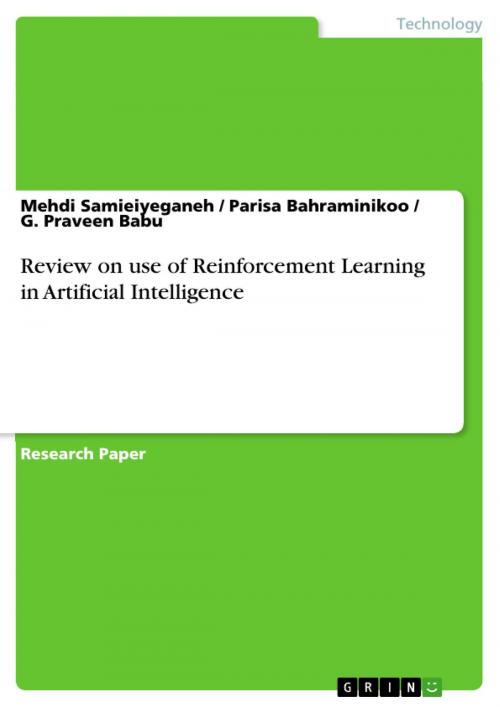Review on use of Reinforcement Learning in Artificial Intelligence
Nonfiction, Computers, Advanced Computing, Artificial Intelligence| Author: | Mehdi Samieiyeganeh, Parisa Bahraminikoo, G. Praveen Babu | ISBN: | 9783656219095 |
| Publisher: | GRIN Publishing | Publication: | June 15, 2012 |
| Imprint: | GRIN Publishing | Language: | English |
| Author: | Mehdi Samieiyeganeh, Parisa Bahraminikoo, G. Praveen Babu |
| ISBN: | 9783656219095 |
| Publisher: | GRIN Publishing |
| Publication: | June 15, 2012 |
| Imprint: | GRIN Publishing |
| Language: | English |
Research Paper (postgraduate) from the year 2012 in the subject Engineering - Artificial Intelligence, grade: none, Jawaharlal Nehru University , language: English, abstract: Human started making machinery that can do the job for them. The technology developed so much that it started involving many other branches of engineering such as electronics, robotics etc. This eventually led to much more complex and smart machinery involving Artificial Intelligence. Reinforcement Learning is a type of Machine Learning, and thereby also a branch of Artificial Intelligence. It allows machines and software agents to automatically determine the ideal behavior within a specific context, in order to maximize its performance. Reinforcement Learning (RL) comes from the animal learning theory. RL does not need prior knowledge, it can autonomously get optional policy with the knowledge obtained by trial- and-error and continuously interact with dynamic environment. As a matter of fact, Reinforcement Learning is defined by a specific type of problem, and all its solutions are classed as Reinforcement Learning algorithms. In the problem, an agent is supposed decide the best action to select based on its current state. When this step is repeated, the problem is known as a Markov Decision Process. A Markov Decision Process is a discrete time stochastic control process. At each time step, the process is in some state s, and the decision maker may choose any action that is available in state's'. Markov Decision Process provides a mathematical framework for modeling decision-making in situations where outcomes are partly random and partly under the control of a decision maker.
Research Paper (postgraduate) from the year 2012 in the subject Engineering - Artificial Intelligence, grade: none, Jawaharlal Nehru University , language: English, abstract: Human started making machinery that can do the job for them. The technology developed so much that it started involving many other branches of engineering such as electronics, robotics etc. This eventually led to much more complex and smart machinery involving Artificial Intelligence. Reinforcement Learning is a type of Machine Learning, and thereby also a branch of Artificial Intelligence. It allows machines and software agents to automatically determine the ideal behavior within a specific context, in order to maximize its performance. Reinforcement Learning (RL) comes from the animal learning theory. RL does not need prior knowledge, it can autonomously get optional policy with the knowledge obtained by trial- and-error and continuously interact with dynamic environment. As a matter of fact, Reinforcement Learning is defined by a specific type of problem, and all its solutions are classed as Reinforcement Learning algorithms. In the problem, an agent is supposed decide the best action to select based on its current state. When this step is repeated, the problem is known as a Markov Decision Process. A Markov Decision Process is a discrete time stochastic control process. At each time step, the process is in some state s, and the decision maker may choose any action that is available in state's'. Markov Decision Process provides a mathematical framework for modeling decision-making in situations where outcomes are partly random and partly under the control of a decision maker.















